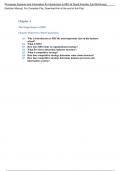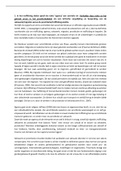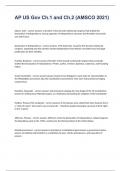Copyright © 2022 Pearson Education, Inc. Chapter 1 The Importance of MIS Chapter Objectives/Study Questions Q1. Why is Introduction to MIS the most important class in the business school? Q2. What is MIS? Q3. How does MIS relate to organizational strategy? Q4. What five forces determine industry structure? Q5. What is competitive strategy? Q6. How does competitive strategy determine value chain structure? Q7. How does competitive strategy determine business processes and information systems? (Processes Systems and Information An Introduction to MIS 4e David Kroenke, Earl McKinney)
(Solution Manual, For Complete File, Download link at the end of this File) 2 of 17 Copyright © 2022 Pearson Education, Inc. List of Key Terms • Abstract reasoning – the ability analyze information and think creatively to develop and manipulate a model or representation a problem , object or an idea. • Barrier to entry - factors that make it difficult for a new business to begin operating in an industry. • Categorical imperative – the principle that one should behave only in a way that one would want the behavior to be a universal law; i.e. we should act in a way that we would like other people to follow. • Competitive strategy – the strategy by which an organization tries to attract customers, makes profits, and differentiates itself from its industry comp etitors . • Experimentation – the ability to develop new business alternatives or ideas and test those alternatives , consistent with available resources. • Five forces model – a model developed by Michael Porter that is used to assess an industry structure. The model identifies five competitive forces that determine profitability: threat of substitutes, threat of new entrants, existing rivals, bargaining power of suppliers, and bargain ing power of customers. • Information Age – the current time where the production, distribution, and control of information are the primary driver of the economy . • Linkages – interactions across value chain activities . • Management information systems (MIS) – the creation, monitoring, and adapting of processes, information systems, and information. • Margin - the difference between the value that an activity generates and the cost of the activity . • Moore’s Law - The number of transistors per square inch on an integrated chip doubles every 18 months. • Primary Activities – the five activities in the value chain that contribute directly to improving the completive advantage of a business. These activities are : inbound logistics, op erations/manufacturing, outbound logistics, sales and marketing, and customer service. • Substitute – a product or a service that performs the same or similar function as another product or service in the market and can be used as alternative to that product . • Support Activities – the four value chain activities that support the five primary activities. Support activities consist of: Procurement, Technology, Human Resources, and Firm Infrastructure. • Systems thinking – the ability to divide a problem or phenomenon into smaller components and understand the relationships, associations, and interactions among those components to help explain the problem or phenomenon . • Value – refers to how much money people are willing to pay for a product or a service ; helps business charge fair and acceptable prices for their products or services. • Value chain – a network of processes or activi ties by which businesses add value to their products 3 of 17 Copyright © 2022 Pearson Education, Inc. MIS InClass 1 In th is chapter, we have asked you to think about work skills that are in demand in business today. For example, one might be good collaboration, another the ability to use software effectively. If you can do these skills well, you will have a better chance at finding and keeping a great job Step 1: In collaboration with teammates, write down six skills that you think are most in demand in business today. Each team member writes down the same list. While th e skills that students will write will vary and a large number of skills can be listed by the teams, major skills should include: abstract thinking, experimentation, collaboration, systems thinking, innovation, team -work, and technology -savvy . Step 2: In discussi on with teammates, identify and circle four of these skills that your team believes are most often lacking in students. Answers will vary from one team to another. Probably most students will circles the skills discussed in the chapter such as abstract th inking, collaboration, systems think ing, and experimentation . Step 3: Evaluate yourself: On which of these four are you capable, and on which of these are you less capable/weakest? Answers will vary among students . For example, some students will indicate that they are strong in collaboration and technology -use. So me students will indicate that they are week in abstract reasoning and systems thinking Step 4: In discussion with teammates, decide which of these four are taught well by other classes at your school and which are not. Schools offer different courses, but most schools offer some of the following courses: Introduction to Information Systems c ourses, like this course, to teach students about current technologies used in business and give students exposure to various technologies such as ERP/SAP. Strategy courses teach students about strategic planning and developing competitive strategies. Supply C hain Management courses teach stude nts about inbound and outbound logistics, inventory, and production . Step 5: Based on what you know about this class, which of the four skills can you practice in this class? How will you know that you are better at them? • Systems Thinking - Students can learn systems thinking when they understand that an information system is composed of components/subsystems that work together to improve business operations and achieve organizational goals. • Collaboration - Students can learn collaboration when the y work in teams and communicate with each other using various technologies (emails, chats, document -sharing etc.) to com plete their teamwork . 4 of 17 Copyright © 2022 Pearson Education, Inc. • Abstract Reasoning - Students can learn abstract thinking from Chapter 5, which discusses processes redesigns and improvements to develop As -Is and Ought -to-Be diagrams. • Ability to Experiment - (may not be directly taught in this cou rse because students are not given resources to experiment with different models or solutions) .







